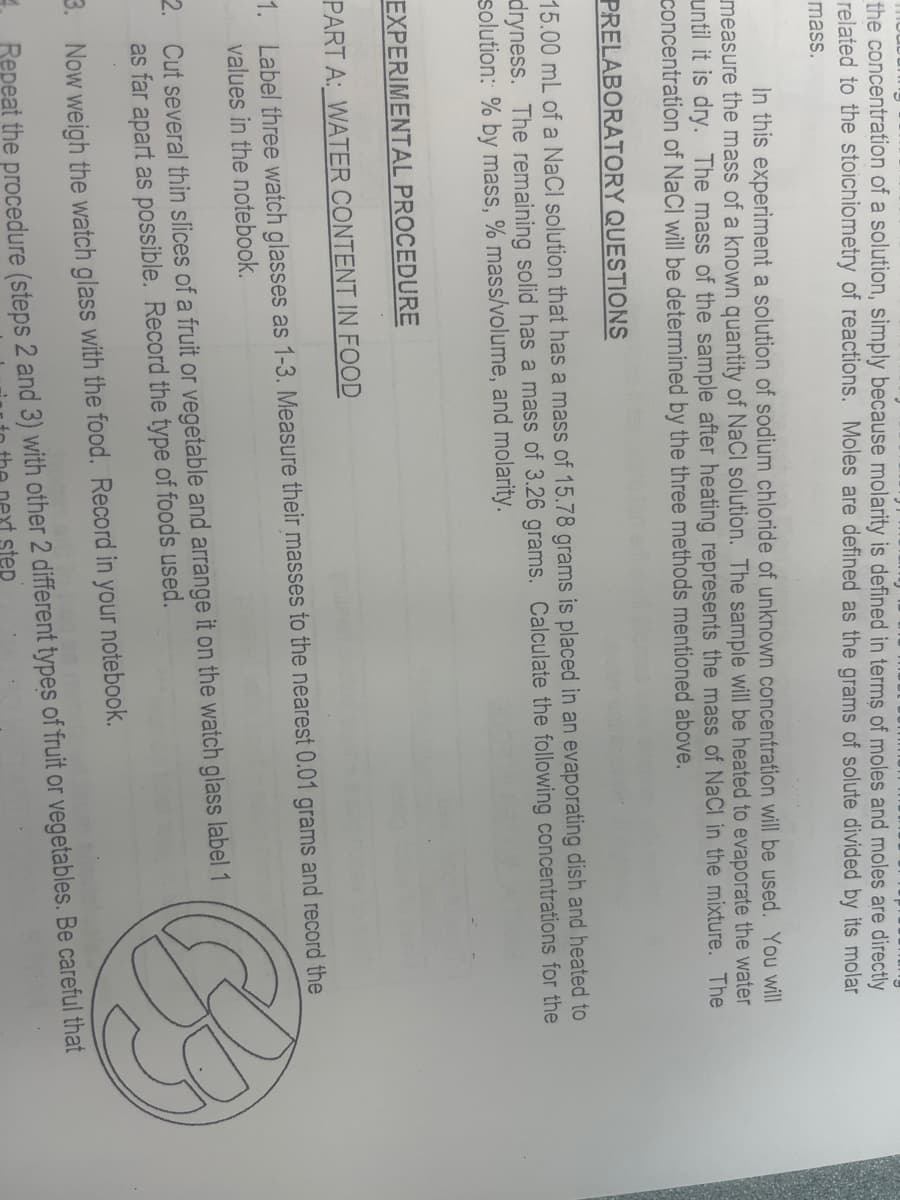15.00 mL of a NaCl solution that has a mass of 15.78 grams is placed in an evaporating dish and heated to concentrations for the dryness. The remaining solid has a mass of 3.26 grams. Calculate the following solution: % by mass, % mass/volume, and molarity.
15.00 mL of a NaCl solution that has a mass of 15.78 grams is placed in an evaporating dish and heated to concentrations for the dryness. The remaining solid has a mass of 3.26 grams. Calculate the following solution: % by mass, % mass/volume, and molarity.
Principles of Modern Chemistry
8th Edition
ISBN:9781305079113
Author:David W. Oxtoby, H. Pat Gillis, Laurie J. Butler
Publisher:David W. Oxtoby, H. Pat Gillis, Laurie J. Butler
Chapter15: Acid–base Equilibria
Section: Chapter Questions
Problem 98AP
Related questions
Question
I do not understand this pre lab question

Transcribed Image Text:the concentration of a solution, simply because molarity is defined in terms of moles and moles are directly
related to the stoichiometry of reactions. Moles are defined as the grams of solute divided by its molar
mass.
In this experiment a solution of sodium chloride of unknown concentration will be used. You will
measure the mass of a known quantity of NaCl solution. The sample will be heated to evaporate the water
until it is dry. The mass of the sample after heating represents the mass of NaCl in the mixture. The
concentration of NaCl will be determined by the three methods mentioned above.
PRELABORATORY QUESTIONS
15.00 mL of a NaCl solution that has a mass of 15.78 grams is placed in an evaporating dish and heated to
dryness. The remaining solid has a mass of 3.26 grams. Calculate the following concentrations for the
solution: % by mass, % mass/volume, and molarity.
EXPERIMENTAL PROCEDURE
PART A: WATER CONTENT IN FOOD
1. Label three watch glasses as 1-3. Measure their masses to the nearest 0.01 grams and record the
values in the notebook.
2. Cut several thin slices of a fruit or vegetable and arrange it on the watch glass label 1
as far apart as possible. Record the type of foods used.
3. Now weigh the watch glass with the food. Record in your notebook.
Repeat the procedure (steps 2 and 3) with other 2 different types of fruit or vegetables. Be careful that
step
Expert Solution
This question has been solved!
Explore an expertly crafted, step-by-step solution for a thorough understanding of key concepts.
Step by step
Solved in 5 steps with 5 images

Knowledge Booster
Learn more about
Need a deep-dive on the concept behind this application? Look no further. Learn more about this topic, chemistry and related others by exploring similar questions and additional content below.Recommended textbooks for you

Principles of Modern Chemistry
Chemistry
ISBN:
9781305079113
Author:
David W. Oxtoby, H. Pat Gillis, Laurie J. Butler
Publisher:
Cengage Learning

Chemistry: An Atoms First Approach
Chemistry
ISBN:
9781305079243
Author:
Steven S. Zumdahl, Susan A. Zumdahl
Publisher:
Cengage Learning

Chemistry
Chemistry
ISBN:
9781305957404
Author:
Steven S. Zumdahl, Susan A. Zumdahl, Donald J. DeCoste
Publisher:
Cengage Learning

Principles of Modern Chemistry
Chemistry
ISBN:
9781305079113
Author:
David W. Oxtoby, H. Pat Gillis, Laurie J. Butler
Publisher:
Cengage Learning

Chemistry: An Atoms First Approach
Chemistry
ISBN:
9781305079243
Author:
Steven S. Zumdahl, Susan A. Zumdahl
Publisher:
Cengage Learning

Chemistry
Chemistry
ISBN:
9781305957404
Author:
Steven S. Zumdahl, Susan A. Zumdahl, Donald J. DeCoste
Publisher:
Cengage Learning


Introductory Chemistry: A Foundation
Chemistry
ISBN:
9781337399425
Author:
Steven S. Zumdahl, Donald J. DeCoste
Publisher:
Cengage Learning

World of Chemistry, 3rd edition
Chemistry
ISBN:
9781133109655
Author:
Steven S. Zumdahl, Susan L. Zumdahl, Donald J. DeCoste
Publisher:
Brooks / Cole / Cengage Learning